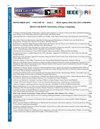生物医学应用的柔性低温射频等离子体源
IF 1.3
4区 工程技术
Q3 COMPUTER SCIENCE, INFORMATION SYSTEMS
引用次数: 0
摘要
一种柔性低温等离子体(LTP)源装置是利用射频(RF)发生器通过自制的l形匹配网络耦合到同轴电缆上,并用柔软的塑料软管传输气体流并屏蔽同轴电缆直至反应器喷嘴。在正常情况下,阻抗匹配网络提供了至少94.11%的电力传输。描述了LTP器件的结构,并通过光学发射光谱和电耗进行了表征。该程序对于确定产生的等离子体在热敏材料(主要是有机物)上的适当应用,以提供有关其物理化学活性的充分信息至关重要。生成的LTP与周围空气颗粒相互作用,产生活性氧和活性氮(RONS),由于其强烈的生化反应性,这些活性氧和活性氮具有杀菌和防腐性能。LTP源器件在正常工作条件下产生的电磁辐照、紫外线发射和热表面效应可以安全地应用于热敏性物质。通过大肠杆菌、粪肠球菌的定性失活试验和大肠杆菌的定量失活试验验证了装置的失活性能。该装置在浓度为3.6106菌落形成单位/mL (CFU/mL)的条件下,在16w条件下180 s灭活99.996%的大肠杆菌,这一结果对应于大肠杆菌活力降低4.43-log10。本文章由计算机程序翻译,如有差异,请以英文原文为准。
Flexible Low-Temperature RF Plasma Source for Biomedical Applications
A flexible low-temperature plasma (LTP) source device was developed utilizing a radiofrequency (RF) generator coupled to a coaxial cable through a homemade L-shape matching network and a supple plastic hose that conveys a gas flow and shields the coaxial cable up to the reactors nozzle. The impedance matching network provides an electric power transfer of minimum of 94.11% operating under normal conditions. The LTP device arrangement is described, and later characterized via optical emission spectroscopy and electric power consumption. This procedure is essential to determine the adequate application of the generated plasma over heat-sensitive materials, primarily organic matter, to provide adequate information about its physicochemical activity. The produced LTP interacts with surrounding air particles, generating reactive oxygen and nitrogen species (RONS) that exhibit bactericidal and antiseptic properties due to their strong biochemical reactivity. The electromagnetic irradiation, ultraviolet (UV) emission, and thermal surface effect produced under normal working conditions of the LTP source device are safe to apply to heat-sensitive matter. The devices inactivation property was validated through qualitative deactivation trials of Escherichia coli and Enterococcus faecalis and quantitative deactivation trials of Escherichia coli. The device inactivated 99.996% of E. coli at a concentration of 3.6106 colony forming units per mL (CFU/mL) in 180 s at 16 W, this result corresponds to a 4.43-log10 reduction in E. coli viability.
求助全文
通过发布文献求助,成功后即可免费获取论文全文。
去求助
来源期刊

IEEE Latin America Transactions
COMPUTER SCIENCE, INFORMATION SYSTEMS-ENGINEERING, ELECTRICAL & ELECTRONIC
CiteScore
3.50
自引率
7.70%
发文量
192
审稿时长
3-8 weeks
期刊介绍:
IEEE Latin America Transactions (IEEE LATAM) is an interdisciplinary journal focused on the dissemination of original and quality research papers / review articles in Spanish and Portuguese of emerging topics in three main areas: Computing, Electric Energy and Electronics. Some of the sub-areas of the journal are, but not limited to: Automatic control, communications, instrumentation, artificial intelligence, power and industrial electronics, fault diagnosis and detection, transportation electrification, internet of things, electrical machines, circuits and systems, biomedicine and biomedical / haptic applications, secure communications, robotics, sensors and actuators, computer networks, smart grids, among others.
 求助内容:
求助内容: 应助结果提醒方式:
应助结果提醒方式:


